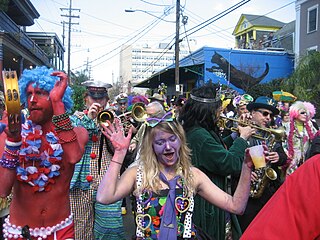
Mardi Gras refers to events of the Carnival celebration, beginning on or after the Christian feasts of the Epiphany and culminating on the day before Ash Wednesday, which is known as Shrove Tuesday. Mardi Gras is French for "Fat Tuesday", reflecting the practice of the last night of eating rich, fatty foods before the ritual Lenten sacrifices and fasting of the Lenten season.

Carnival is a Catholic festive season that occurs before the liturgical season of Lent. The main events typically occur during February or early March, during the period historically known as Shrovetide. Carnival typically involves public celebrations, including events such as parades, public street parties and other entertainments, combining some elements of a circus. Elaborate costumes and masks allow people to set aside their everyday individuality and experience a heightened sense of social unity. Participants often indulge in excessive consumption of alcohol, meat, and other foods that will be forgone during upcoming Lent. Traditionally, butter, milk, and other animal products were not consumed "excessively", rather, their stock was fully consumed as to reduce waste. This festival is known for being a time of great indulgence before Lent, with drinking, overeating, and various other activities of indulgence being performed. For example, Pancakes, donuts, and other desserts are prepared and eaten for a final time. During Lent, animal products are eaten less, and individuals have the ability to make a Lenten sacrifice, thus giving up a certain object or activity of desire.
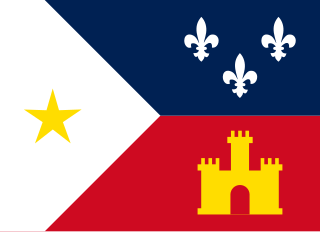
The Cajuns, also known as Louisiana Acadians, are an ethnic group mainly living in the U.S. state of Louisiana.

Iota is a town in Acadia Parish, Louisiana. The population was 1,500 at the 2010 census.

Academic dress is a traditional form of clothing for academic settings, mainly tertiary education, worn mainly by those who have obtained a university degree, or hold a status that entitles them to assume them. It is also known as academical dress, academicals, and, in the United States, as academic regalia.

The holiday of Mardi Gras is celebrated in all of Louisiana, including the city of New Orleans. Celebrations are concentrated for about two weeks before and through Shrove Tuesday, the day before Ash Wednesday. Usually there is one major parade each day ; many days have several large parades. The largest and most elaborate parades take place the last five days of the Mardi Gras season. In the final week, many events occur throughout New Orleans and surrounding communities, including parades and balls.
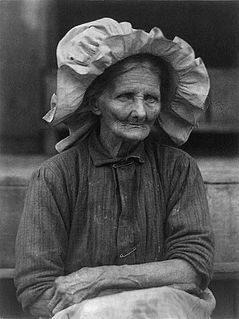
Bonnet has been used as the name for a wide variety of headgear for both sexes—more often female—from the Middle Ages to the present. As with "hat" and "cap", it is impossible to generalize as to the styles for which the word has been used, but there is for both sexes a tendency to use the word for pop styles in soft material and lacking a brim, or at least one all the way round, rather than just at the front. Yet the term has also been used, for example, for steel helmets. This was from Scotland, where the term has long been especially popular.

The cope is a liturgical vestment, more precisely a long mantle or cloak, open in front and fastened at the breast with a band or clasp. It may be of any liturgical colour.
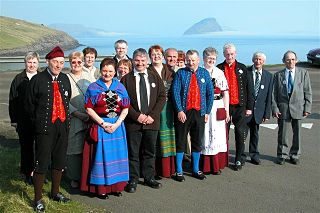
A folk costume expresses an identity through costume, which is usually associated with a geographic area or a period of time in history. It can also indicate social, marital or religious status. If the costume is used to represent the culture or identity of a specific ethnic group, it is usually known as ethnic costume. Such costumes often come in two forms: one for everyday occasions, the other for traditional festivals and formal wear.

The Asian conical hat, commonly known as an Asian rice hat, or just rice hat, coolie hat or Chinese hat, chinaman’s hat (Australia), oriental hat, or farmer's hat, is a simple style of conically shaped sun hat originating in East, South and Southeast Asia; and notable in modern-day nations and regions of China, parts of Outer Manchuria, Bangladesh, Bhutan, Cambodia, India, Indonesia, Japan, Korea, Laos, Malaysia, Myanmar, Philippines,, Nepal, Tibet, Thailand, and Vietnam. It is kept on the head by a cloth or fiber chin strap.

Pointed hats have been a distinctive item of headgear of a wide range of cultures throughout history. Although often suggesting an ancient Indo-European tradition, they were also traditionally worn by women of Lapland, the Japanese, the Mi'kmaq people of Atlantic Canada, and the Huastecs of Veracruz and Aztec. The Kabiri of New Guinea have the diba, a pointed hat glued together.

The hennin was a headdress in the shape of a cone, steeple, or truncated cone worn in the Late Middle Ages by European women of the nobility. They were most common in Burgundy and France, but also elsewhere, especially at the English courts, and in Northern Europe, Hungary and Poland. They were little seen in Italy. It is unclear what styles the word hennin described at the time, though it is recorded as being used in French areas in 1428, probably before the conical style appeared. The word does not appear in English until the 19th century. The term is therefore used by some writers on costume for other female head-dresses of the period.

A chaperon was a form of hood or, later, highly versatile hat worn in all parts of Western Europe in the Middle Ages. Initially a utilitarian garment, it first grew a long partly decorative tail behind called a liripipe, and then developed into a complex, versatile and expensive headgear after what was originally the vertical opening for the face began to be used as a horizontal opening for the head. It was especially fashionable in mid-15th century Burgundy, before gradually falling out of fashion in the late 15th century and returning to its utilitarian status. It is the most commonly worn male headgear in Early Netherlandish painting, but its complicated construction is often misunderstood.

The first unofficial American Mardi Gras took place on March 3, 1699, when French explorers Pierre Le Moyne D'Iberville and Sieur de Bienville landed near present-day New Orleans, Louisiana. They held a small celebration and dubbed their landing spot Point du Mardi Gras. There were many other unofficial French celebrations on the Gulf and Atlantic coasts during the 17th century.
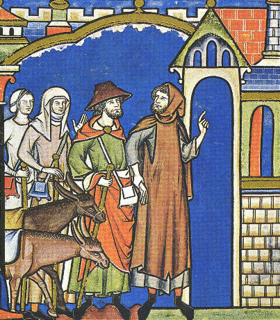
Costume during the thirteenth century in Europe was very simple for both men and women, and quite uniform across the continent. Male and female clothing was relatively similar, and changed very slowly, if at all. Most clothing, especially outside the wealthier classes, remained little changed from three or four centuries earlier. The century saw great progress in the dyeing and working of wool, which was by far the most important material for outerwear. For the rich, colour and rare fabrics such as silk from the silkworm was very important. Blue was introduced and became very fashionable, being adopted by the Kings of France as their heraldic colour.

The Courir de Mardi Gras is a traditional Mardi Gras event held in many Cajun and Creole communities of French Louisiana on the Tuesday before Ash Wednesday. Courir de Mardi Gras is Louisiana French for "Fat Tuesday Run". This rural Mardi Gras celebration is based on early begging rituals, similar to those still celebrated by mummers, wassailers, and celebrants of Halloween. As Mardi Gras is the celebration of the final day before Lent, celebrants drink and eat heavily, dressing in specialized costumes, ostensibly to protect their identities. In Acadiana, popular practices include wearing masks and costumes, overturning social conventions, dancing, drinking alcohol, begging, trail riding, feasting, and whipping. Mardi Gras is one of the few occasions when people are allowed to publicly wear masks in Louisiana. Dance for a Chicken: The Cajun Mardi Gras, a documentary by filmmaker Pat Mire, provides great insight into the history and evolution of this cultural tradition. In popular culture, two HBO series also make reference to the tradition.

Mardi Gras in the United States is not observed nationally across the country, largely due to the country's Protestant and Anglo roots. Mardi Gras and Carnival are mostly Catholic holidays, while the United States has a Protestant majority population. However, a number of cities and regions in the U.S. have notable Mardi Gras or Carnival celebrations. Most of these places trace their Mardi Gras celebrations to French, Spanish, and other Catholic colonial influences on the settlements over their history. The earliest Carnival celebration in North America occurred at a place on the west bank of the Mississippi river about 60 miles downriver from where New Orleans is today; this Mardi Gras on the 3 March 1699 and in honor of this holiday, Pierre Le Moyne, Sieur d'Iberville, a 38-year-old French Canadian, named the spot Point du Mardi Gras near Fort Jackson. The earliest organized Carnival celebrations occurred in Mobile, Biloxi, New Orleans, and Pensacola, which have each developed separate traditions. In addition, modern activities generally vary from city to city across the U.S.
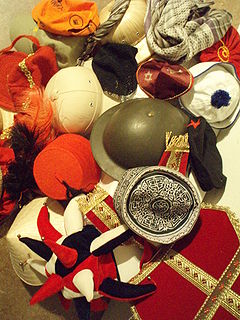
Headgear, headwear, or headdress is the name given to any element of clothing which is worn on one's head, including hats, helmets, turbans and many other types. Headgear is worn for many purposes, including protection against the elements, decoration, or for religious or cultural reasons, including social conventions.
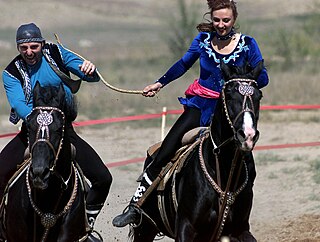
Kazakh clothing, worn by the Kazakh people, is often made of materials suited to the region's extreme climate and the people's nomadic lifestyle. It is commonly decorated with elaborate ornaments made from bird beaks, animal horns, hooves and feet. Although contemporary Kazakhs usually wear Western dress, the Turkic people wear more traditional clothing for holidays and special occasions.



















